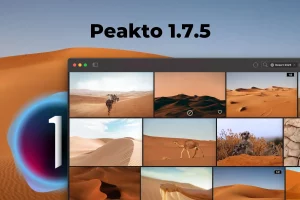Capture One, also known as Capture One Pro, is the photo editing software designed and created by Phase One. It has all the essential tools and high-end performance required to enable photographers to capture, organize, edit, share and print high-quality images flexibly and efficiently. It competes directly with Adobe, Lightroom and Photoshop image editing software.
Often considered to be aimed at a very high level of professional image editing, Capture One has proven itself to professional photographers using the highest quality cameras on the market. While today it is well known and recognized, especially in photo studios, it has had to travel a long way to get here. Let’s delve into Capture One’s history to better understand what it’s all about.
Table of contents
Capture One: from an image converter to an independent brand
Capture One is now one of the most powerful image editing software programs on the market. But let’s go back: what’s the story behind such a success?
The creation of Phase One, a digital company
In order to better understand the history of Capture One, we need to look back at the creation of the company that developed it. Phase One was founded in Denmark in the early 1990s by Samir Léhaff and quickly became a digital pioneer. The company developed basic imaging technologies and a range of digital cameras under the same name. It very quickly distinguished itself thanks to the image quality it offered, particularly in terms of resolution and color fidelity. In addition to products for professional photographers, Phase One has offered products for various sectors since its inception, such as software for aerial cartography or the digitization of cultural heritage.

The founding of an independent brand
Among its many products, the company developed Capture One in 1994, which was, at the time, a RAW file conversion tool for Phase One cameras. The software was therefore designed for these cameras only and did not support cameras of other brands. In 2003, the company wanted to distinguish between the brand’s cameras and the Capture One software. Indeed, the company had greater ambitions and wanted to grow to be compatible with the cameras of major brands such as Canon, Nikon, Sony or Fujifilm. The independent brand Capture One was thereby created and began to support many other camera brands. For several years, it also offered a Fujifilm version and a Sony version.
2020: Axcel bought shares in Capture One
In 2020, Axcel decided to buy back the majority of Phase One shares. Axcel is a private equity investment firm of high-tech companies. Phase One was placed under the leadership of Rafel Orta, but the majority of its existing management team continued to reinvest in order to maintain a significant stake in the company. Capture One has been operating as an independent entity since 2020, which has enabled it to become a leader in the image processing market and to become the success we have seen today with photographers and businesses. This is also true of Image Capture Solutions, which is a solution that provides high-tech medium format camera systems for industrial and specialty photography applications.
Axcel’s partnership with Phase One links technical expertise and experience in growing software companies. The positioning of Phase One and its software was strengthened, leading to significant revenue growth. The company succeeded in increasing its turnover by about 40% thanks to the sale of its software solutions.
Capture One, passion above all
Capture One is above all a story of passion for photographic art, which it considers to be an art that brings beauty and joy to everyday life.
Building a community
When we look at the creations of Capture One users, we discover very quickly a world rich in colors and creativity, and this in all areas of photography: portraits, landscapes, fashion, street photography, sport, and more. The history of Capture One is marked by the construction of this great community of talents. Capture One has proven to be much more than just photo editing software. It is also a platform that gives a voice to creative people who can tell their story – they can, in particular, discuss their relationship to color.
It is thanks to this close-knit community that Capture One remains ambitious in its projects. Its ambition is to offer a product that allows enthusiasts to share their vision of the world in the best possible way. To do this, the company is developing its tool alongside its users so that it can offer them a product that fully meets their needs.
The search for the perfect image
Capture One is always looking for the perfect color, the best quality, the best reproduction of reality possible. If we take a closer look at the different versions that Capture One has offered throughout its history, we can see that the development of the tool is geared towards:
- an editor allowing better color control;
- increasingly faster editing sessions;
- a multi-device workflow;
- a customizable workspace;
- facilitating collaboration between creative people.
With each update and new feature, the company continues to surpass itself by offering ever more powerful photo editing software. It is now compatible with more than 600 camera and lens profiles.

Capture One today: offers
In order to meet the needs of all users, Capture One is expanding its ecosystem and offers many versions of the image editing software. These include:
- Capture One Pro, ideal for the big screen and daily image editing sessions;
- Capture One iPad, ideal for creative people on the go;
- Capture One Live, a version that makes it easier for photographers to collaborate;
- Capture One Enterprise, a business version;
- Capture One Multi-user, a version dedicated to creative teams of two or more people.
Today, the goal of Capture One is to be able to offer tools that allow its users to improve productivity, image quality and creative freedom, focusing in particular on the user experience. The quality of its product is the result of years of work, remaining attentive to photographers and other users.










